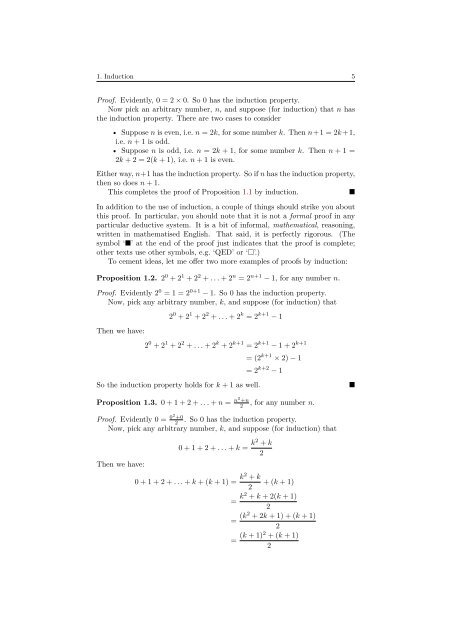Metatheory - University of Cambridge
Metatheory - University of Cambridge
Metatheory - University of Cambridge
Create successful ePaper yourself
Turn your PDF publications into a flip-book with our unique Google optimized e-Paper software.
1. Induction 5<br />
Pro<strong>of</strong>. Evidently, 0 = 2 × 0. So 0 has the induction property.<br />
Now pick an arbitrary number, n, and suppose (for induction) that n has<br />
the induction property. There are two cases to consider<br />
• Suppose n is even, i.e. n = 2k, for some number k. Then n+1 = 2k +1,<br />
i.e. n + 1 is odd.<br />
• Suppose n is odd, i.e. n = 2k + 1, for some number k. Then n + 1 =<br />
2k + 2 = 2(k + 1), i.e. n + 1 is even.<br />
Either way, n+1 has the induction property. So if n has the induction property,<br />
then so does n + 1.<br />
This completes the pro<strong>of</strong> <strong>of</strong> Proposition 1.1 by induction.<br />
■<br />
In addition to the use <strong>of</strong> induction, a couple <strong>of</strong> things should strike you about<br />
this pro<strong>of</strong>. In particular, you should note that it is not a formal pro<strong>of</strong> in any<br />
particular deductive system. It is a bit <strong>of</strong> informal, mathematical, reasoning,<br />
written in mathematised English. That said, it is perfectly rigorous. (The<br />
symbol ‘■’ at the end <strong>of</strong> the pro<strong>of</strong> just indicates that the pro<strong>of</strong> is complete;<br />
other texts use other symbols, e.g. ‘QED’ or ‘□’.)<br />
To cement ideas, let me <strong>of</strong>fer two more examples <strong>of</strong> pro<strong>of</strong>s by induction:<br />
Proposition 1.2. 2 0 + 2 1 + 2 2 + . . . + 2 n = 2 n+1 − 1, for any number n.<br />
Pro<strong>of</strong>. Evidently 2 0 = 1 = 2 0+1 − 1. So 0 has the induction property.<br />
Now, pick any arbitrary number, k, and suppose (for induction) that<br />
Then we have:<br />
2 0 + 2 1 + 2 2 + . . . + 2 k = 2 k+1 − 1<br />
2 0 + 2 1 + 2 2 + . . . + 2 k + 2 k+1 = 2 k+1 − 1 + 2 k+1<br />
= (2 k+1 × 2) − 1<br />
= 2 k+2 − 1<br />
So the induction property holds for k + 1 as well.<br />
■<br />
Proposition 1.3. 0 + 1 + 2 + . . . + n = n2 +n<br />
2<br />
, for any number n.<br />
Pro<strong>of</strong>. Evidently 0 = 02 +0<br />
2<br />
. So 0 has the induction property.<br />
Now, pick any arbitrary number, k, and suppose (for induction) that<br />
Then we have:<br />
0 + 1 + 2 + . . . + k = k2 + k<br />
2<br />
0 + 1 + 2 + . . . + k + (k + 1) = k2 + k<br />
2<br />
+ (k + 1)<br />
= k2 + k + 2(k + 1)<br />
2<br />
= (k2 + 2k + 1) + (k + 1)<br />
2<br />
= (k + 1)2 + (k + 1)<br />
2
















